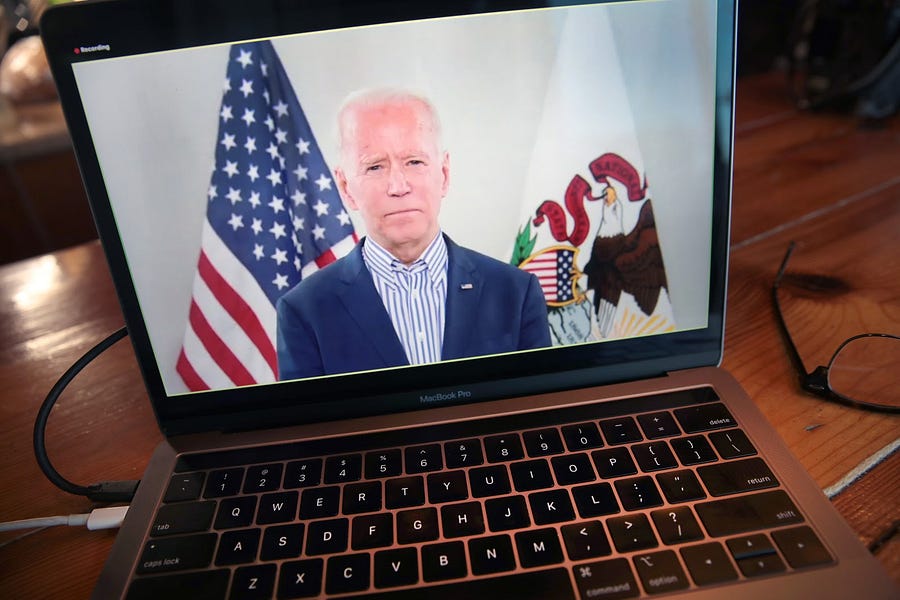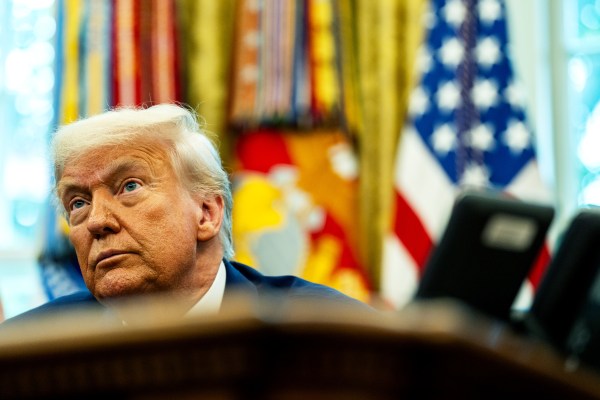Happy Wednesday. We hope all our Wisconsin readers were able to practice social distancing and keep safe in yesterday’s elections. The videos of lines at polling places were simultaneously heartening and infuriating.
Quick Hits: Today’s Top Stories
-
As of Tuesday night, there are now 398,785 confirmed cases of COVID-19 in the United States (an 8.3 percent increase from yesterday) and 12,893 deaths (a 17.3 percent increase from yesterday), according to the Johns Hopkins University COVID-19 Dashboard, leading to a mortality rate among confirmed cases of 3.2 percent (the true mortality rate is difficult to calculate due to incomplete testing regimens). Of 2,054,462 coronavirus tests conducted in the United States, 19.1 percent have come back positive, per the COVID Tracking Project, a separate dataset with slightly different topline numbers.
-
Because most COVID-19 tests are reserved for very sick and high-risk individuals, Ohio is mulling a plan to test a random sample of asymptomatic people across the state. Such a regimen could help researchers better understand how widespread the virus truly is.
-
The Senate is looking to appropriate an additional $250 billion for small businesses—potentially as early as this week—because the $350 billion in funding for the newly created Paycheck Protection Program has already begun to run dry. Many small business owners have experienced difficulties applying for and receiving these benefits.
-
President Trump removed Glenn Fine—the acting Defense Department inspector general—just as he was set to lead a congressionally created panel responsible for overseeing the implementation of the coronavirus economic relief bill.
-
Acting Navy Secretary Thomas Modly resigned Tuesday in the wake of his controversial firing of Capt. Brett Crozier. Audio had leaked of Modly accusing Crozier of either purposefully violating the Uniform Code of Military Justice, or being “too naive or too stupid to be the commanding officer of a ship like this.”
-
The White House communications team underwent a shakeup on Tuesday, with with Kayleigh McEnany, a Trump re-election campaign aide, replacing Stephanie Grisham as press secretary; Alyssa Farah, a former Pentagon spokeswoman and vice presidential press secretary, becoming the new director of strategic communications; and Ben Williamson, a close adviser to new chief of staff Mark Meadows, assuming the role of senior communications adviser. Grisham, who never held a press briefing during her tenure, is returning to the East Wing of the White House, where she will serve as Melania Trump’s chief of staff.
-
Legendary singer-songwriter John Prine succumbed to COVID-19 on Tuesday at the age of 73. He had been hospitalized in Nashville last month.
Election 2020: It’s Still Happening

This week, the incumbent Republican president had a 15-minute phone call with the presumptive Democratic nominee, and … nobody cared. The Democratic National Committee postponed its presidential convention, and it was buried on page A-22 of the New York Times. The surest sign Joe Biden is still running for president is a weekly podcast he’s hosting from his basement.
This is what a presidential race looks like when no one is watching.
Veepstakes: Biden had previously committed to picking a woman as his vice president, and over the weekend, Biden informed Bernie Sanders that he was beginning the process of searching for a potential running mate. A name that wasn’t on the top of anyone’s list before March is now the front runner: Michigan Gov. Gretchen Whitmer, who rocketed to fame as her state reported the third-highest number of coronavirus-related fatalities in the U.S. and the president attacked her for being “in over her head.” Biden interviewed her on his podcast this week without much fanfare. Other names that have emerged from the Biden camp include Sen. Kamala Harris, Sen. Amy Klobuchar, Sen. Elizabeth Warren, Sen. Catherine Cortez Masto, and Rep. Val Demings.
Nomination: Wisconsin held its presidential primary yesterday, but, by court order, the results are not expected to be announced until April 13 to allow for absentee ballots to be counted. While Biden is still expected to clinch the necessary number of pledged delegates when delayed primaries are held, he hasn’t missed the opportunity to try to win over Sanders supporters. In an interview this week, he said of Sanders, “he’s maybe one of a half dozen people in American history who may not be the nominee but has had an impact on American politics in a significant way, in a positive way” and expressed interest in having him join his campaign “not as a vice presidential nominee, but just in engaging in all the things that he’s worked so hard to do, many of which I agree with.” In the meantime, Sanders—far behind in delegates—has said only that he is assessing his path forward.
November: The battle over voting access in November is already heating up. Yesterday, the Texas Democratic Party filed a lawsuit to expand vote-by-mail access. Congressional Democrats fought for billions for election assistance in the coronavirus relief package. But as Democrats try to move toward more mail-in ballots across the country, Biden took a less firm stance this week. “I’d much prefer to have on—you know, in-person voting, but it depends,” Biden said, “but we cannot, we cannot delay or postpone a constitutionally required November election.” The president, on the other hand, was clear about where he stood when asked about the relief package language: “They had things, levels of voting that if you’d ever agreed to it, you’d never have a Republican elected in this country again.”
Can the U.S. Replicate South Korea’s Testing Strategy? Should We?
We’ve spent a lot of time talking about what the next steps will look like for coronavirus containment, once we emerge from our current dark period of peaking hospitalizations and deaths. The success of countries like South Korea in limiting outbreaks through aggressive governmental contact tracing has provided hope that, if we can only build out our testing resources and infrastructure, we too might be able to track new cases sufficiently so as to be able, carefully and slowly, to resume large chunks of our daily lives and end the economic free-fall.
South Korea’s contact tracing system is a marvel. Daily, public reports tabulate not only the number and location of new coronavirus cases, but also their origin, which they have been able to establish more than 80 percent of the time. The information is broken down in easily graspable fashion, leaving little doubt for South Koreans about where the local hotspots still are:
“From the wine bar located in Pyeongtaek, Gyeonggi Province, 13 cases (wine bar = 9, contacts/families = 4) have been confirmed since 1 April. Epidemiological investigation is currently on-going.”
“From Uijeongbu St. Mary’s Hospital in Gyeonggi Province, 5 additional cases were confirmed. In total, 27 cases (patients = 10; staff/workers = 10; family/visitors = 7) have been confirmed since 29 March. Inpatients are in cohort isolation. Contacts are in home quarantine. Investigation into chains of transmission and contacts is underway.”
For many, this effort presents hope that a democratically governed country can marshal the will to really clamp down on the epidemic: “I just want to remind everybody that South Korea is extremely trustworthy,” Yale professor of public health Dr. Howard Forman told The Dispatch. “South Korea does this. There’s no way that they’re faking it, there’s no way that they’re lying about stuff, there’s no incentive for them to be suppressing data at this point. And if they can do it, we can do it.”
That said, replicating South Korea’s containment effort—even when we’ve built up the testing capacity for it—will be easier said than done. The first problem is logistical. Building out one such government system is already a remarkable feat. Building 50 of them across the U.S., and getting them all to play nicely with each other? That’s another order of difficulty altogether.
But set that aside for now. The more fundamental difficulty relates to what a major coronavirus surveillance program would entail, and how much mass surveillance we’re comfortable permitting the government to build into it.
Successfully nipping the pandemic in the bud in South Korea wasn’t just a matter of acting fast and staying diligent. Getting an airtight picture of who each new carrier might have infected has involved the government vacuuming up massive amounts of personal data, including cell phone location data and credit card records. In America, collecting this sort of data on citizens who haven’t been charged with crimes tends not to go over well with civil liberties advocates.
Which threatens to leave us with an unenviable dilemma: Would we rather remain theoretically freer but stuck jobless and at home, or hand ourselves over even more completely to constant federal surveillance in order to resume our lives and work?
Additional Signs of Economic Contraction
While in many ways—as Ross Douthat argues in his latest column—we continue to be flying blind in the face of the coronavirus pandemic, medical experts (and their models) seem to finally be able to reach general conclusions regarding the full scope of the epidemiological crisis. The same cannot be said for the economic one, which in many ways remains a black box even for the foremost of experts.
We know vast portions of our economy have temporarily shut down, and we know that a record-breaking 10 million Americans have applied for unemployment insurance over the past two weeks. Many fear that figure is merely a starting point, with estimates of when and how business activity will begin to return ambiguous at best.
The economy is a Rube Goldberg machine much more than it is a light switch. Those hoping for a quick and easy return to normalcy whenever the virus subsides are almost assuredly in for a rude awakening, with individual COVID-19-related disruptions—business closures, changing consumer habits, supply chain rejiggering—rippling throughout the country in ways we’d be foolish to predict.
Here are some recent developments we’re keeping an eye on.
-
Department stores and mall fixtures like like Macy’s, J.C. Penney, Gap, and Kohl’s have closed hundreds of stores and furloughed hundreds of thousands of workers.
-
The Broadmoor Hotel in Colorado Springs laid off more than 1,400 workers, indicative of a broader trend. “So few people are showing up that many hotels don’t see the point in staying open.”
-
S&P Global—a financial research firm—predicted AMC Entertainment will run out of cash at some point this summer, potentially unable to reopen.
-
Businesses one layer removed from the direct impact of coronavirus are feeling the squeeze. Toast—a software company that caters to the restaurant industry—announced it was cutting about half its staff.
-
News organizations are furloughing employees and/or docking pay in efforts to keep the lights on.
Worth Your Time
-
When it comes to tracking new coronavirus cases down the road, mass surveillance à la South Korea might not be the only way to go. Former FDA chief Scott Gottlieb, a consistently incisive voice since the beginning of this crisis, released his policy blueprint yesterday for how to build out the necessary infrastructure without resorting to methods like cell location data, which “is unlikely to have adequate discriminating ability or adoption to achieve public utility, while introducing serious privacy, security, and logistical concerns.”
-
At National Review, Rachel and Joshua Kleinfeld have written about the best ways to safely hold an election during a pandemic. “The election must be held. And people who want to vote must be able to do so without fear of infection and without worsening the pandemic. To uphold those principles, we must expand no-excuse absentee voting and make drive-through voting possible now.”
-
Minority communities are suffering disproportionately during the coronavirus pandemic. Despite making up only about 33 percent of the population in Louisiana, for example, African Americans account for “slightly more than 70 percent” of all COVID-19 deaths in the state. This piece in Politico—from Laura Barrón-López, Holly Otterbein, and Maya King—explores why such communities are being hit hardest and what can be done to rectify the problem.
-
Dr. Anthony Fauci expanded on this last point in yesterday’s coronavirus task force briefing. “Sometimes, when you’re in the middle of a crisis like we are now with the coronavirus, it does … ultimately shine a very bright light on some of the real weaknesses and foibles in our society.” Take the two minutes.
Presented Without Comment
Also Presented Without Comment
Also Also Presented Without Comment
Something Bittersweet
We love this live rendition of “Lake Marie,” but John Prine is gone far, far too soon. God bless him and his loved ones.
Toeing the Company Line
-
If you missed Daniel Vaughan’s great piece yesterday about China’s total public relations takeover of the World Health Organization—and what the U.S. can do to counteract it—you really should give it a read.
-
We’re starting to get a little concerned about how many episodes of The Remnant Jonah’s churning out these days. Yesterday’s edition: A great interview with AEI demographer and friend of The Dispatch Lyman Stone, on—what else?—the coronavirus: how we got here, China’s role in the outbreak, and what comes next.
-
David’s latest French Press (🔒)offers a comprehensive breakdown of what he terms “one of the most important sub-stories of the entire coronavirus outbreak”: the saga of Capt. Brett Crozier’s relief from command of the USS Theodore Roosevelt.
-
On the site today, we have a piece from Ward Carroll, a longtime naval aviator, on the Roosevelt kerfuffle and the hazards of trying to please the boss.
-
Parallels between now and the 1918 Spanish flu epidemic keep popping up. On the site, Christian Schneider has a look back at what voting was like in the midterm elections of 1918. “As Election Day drew close, many of the quarantine orders around America were lifted. Polls in large cities remained open, with the provision that voters were to wear masks as they made their way to vote. Two days before the election, Mayor Frederick Thomas Woodman of Los Angeles issued a public letter urging people to get out and vote, pandemic be damned.”
-
Passover starts at sundown, and Melissa Langsam Braunstein writes about how the relative comforts of American typically make it challenging to envision oneself as “former Israelite slave witnessing the Ten Plagues and leaving Egypt as part of the Exodus.” At least until this year.
Let Us Know
Where do you fall on the South Korean test-and-trade model? Would you be willing to fork over—at least temporarily—location and credit card data if it meant we could safely begin a gradual transition toward reopening our economy? Why or why not?
Reporting by Declan Garvey (@declanpgarvey), Andrew Egger (@EggerDC), Alec Dent (@Alec_Dent), Sarah Isgur (@whignewtons), and Steve Hayes (@stephenfhayes).
Photograph of Joe Biden by Scott Olson/Getty Images.







Please note that we at The Dispatch hold ourselves, our work, and our commenters to a higher standard than other places on the internet. We welcome comments that foster genuine debate or discussion—including comments critical of us or our work—but responses that include ad hominem attacks on fellow Dispatch members or are intended to stoke fear and anger may be moderated.
With your membership, you only have the ability to comment on The Morning Dispatch articles. Consider upgrading to join the conversation everywhere.